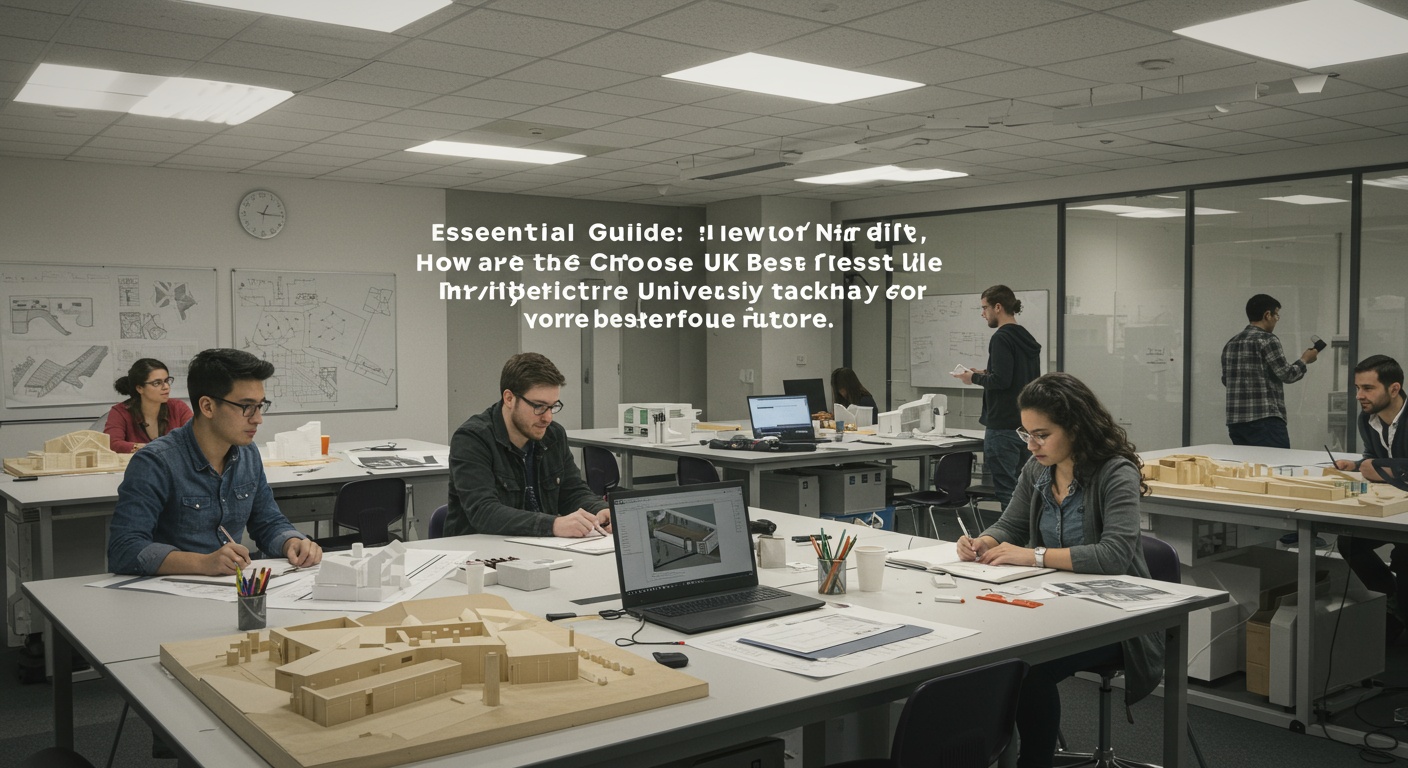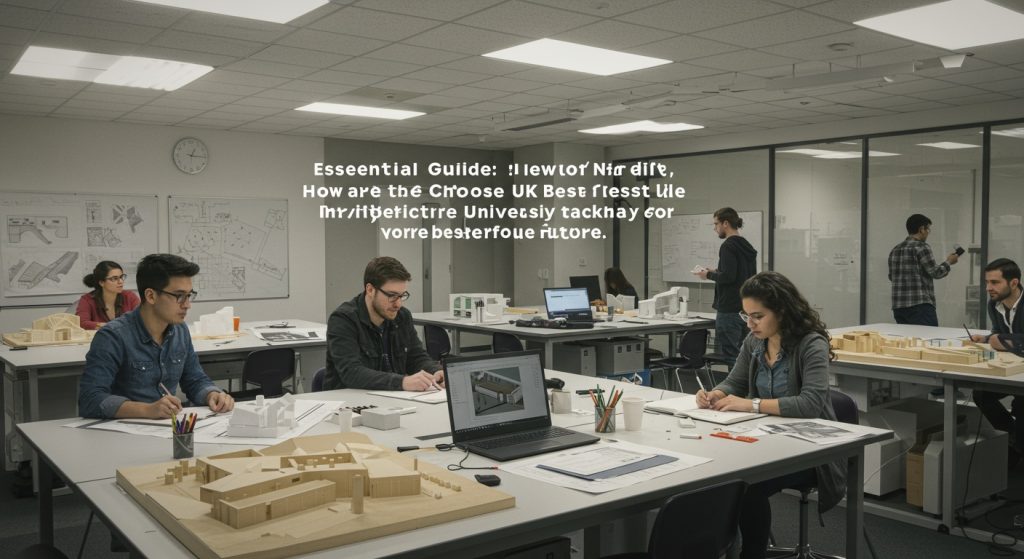Embarking on an architectural career necessitates a meticulous selection of your foundational Part 1 program, as the UK’s diverse landscape of architecture universities offers varied pedagogical strengths. Beyond traditional design studios, contemporary curricula often integrate advanced computational design, climate-resilient strategies. Material innovation, reflecting industry shifts towards net-zero construction and digital fabrication. Prospective students must critically evaluate each institution’s ARB validation status, specific research clusters—such as urban regeneration or heritage conservation—and their emphasis on practical experience through live projects or industry placements. Understanding these nuances, from a university’s unique studio culture to its alumni network, becomes paramount in securing an education that aligns with your future specialisation within the dynamic architectural profession.

Understanding the Landscape of UK Architecture Education
Embarking on a career in architecture is an incredibly exciting prospect. Choosing where to lay your foundational knowledge is perhaps the most pivotal decision you’ll make. The United Kingdom boasts a world-renowned architectural heritage and an education system that is equally esteemed. Before diving into specific institutions, it’s crucial to grasp the unique structure of architectural education within the UK, which distinguishes it from many other countries.
The Three-Part System: A Gateway to Professional Practice
UK architectural education is meticulously structured into a three-part system, designed to ensure comprehensive theoretical knowledge and practical experience. This phased approach is a hallmark of the architecture universities UK offers, leading to professional registration.
- Part 1: The Undergraduate Degree (Typically BA or BSc in Architecture)
This is your entry point, usually a three-year full-time course. It focuses on design principles, architectural history and theory, building technology. Environmental design. Upon successful completion, you receive an undergraduate degree that is a prerequisite for your next steps. - Part 2: The Postgraduate Degree (Typically MArch or Diploma in Architecture)
Following Part 1, you typically gain a minimum of one year of practical experience in an architectural practice before embarking on a two-year full-time postgraduate program. This stage delves deeper into complex design challenges, research methodologies. Professional studies. It’s a significant leap in developing your independent critical thinking and design prowess. - Part 3: Professional Practice & Examination
This final stage involves a minimum of 24 months of verified practical experience (including the year between Part 1 and Part 2) and the completion of a professional practice examination. This exam assesses your competence in architectural management, practice. Law. Only upon passing Part 3 are you eligible to register as a fully qualified architect with the Architects Registration Board (ARB) and become a chartered member of the Royal Institute of British Architects (RIBA).
Accreditation: The Cornerstones of Quality
When researching architecture universities UK, you’ll frequently encounter two key acronyms: ARB and RIBA. Understanding their roles is fundamental to ensuring your chosen path leads to professional recognition.
- Architects Registration Board (ARB)
- Royal Institute of British Architects (RIBA)
This is the statutory body for architects in the UK. Its primary role is to protect the public by maintaining a register of architects and setting standards for architectural education and practice. Any architectural course you consider must be ARB-validated for your qualifications to be recognised for professional registration. This is non-negotiable for anyone aspiring to be a registered architect in the UK.
While not a statutory body, RIBA is a professional organisation that champions architecture and its value to society. Many, though not all, ARB-validated courses are also RIBA-accredited. RIBA accreditation signifies a high standard of architectural education and offers additional benefits, such as access to professional development resources, networking opportunities. A strong professional community. While ARB validation is mandatory for registration, RIBA accreditation is highly desirable and signifies a commitment to excellence.
Key Factors to Consider When Choosing Your University
With a clear understanding of the UK’s architectural education framework, you’re ready to explore the exciting range of architecture universities UK has to offer. This decision is deeply personal. A holistic approach considering several critical factors will guide you toward the perfect fit.
Course Structure and Specialisations
Architecture programs, even with their core requirements, can vary significantly in their approach and focus. It’s vital to align your interests with a university’s pedagogical philosophy.
- Design-Centric vs. Technology-Driven
- Specialisation Options
- Teaching Methodology
Some universities place a greater emphasis on conceptual design and artistic expression, often found in art school environments, while others lean towards advanced building technologies, digital fabrication. Computational design. Consider which approach resonates more with your aspirations.
Do you dream of designing sustainable buildings, conserving historical landmarks, or shaping urban landscapes? Many architecture universities UK offer modules or even dedicated pathways in areas like sustainable architecture, urban design, architectural conservation, landscape architecture, or even architectural history and theory. Investigate these specialisations to see if they align with your long-term goals. For instance, if you’re passionate about ecological design, look for universities with strong research groups in environmental architecture.
Research whether the program is studio-heavy, project-based, lecture-driven, or a blend. A studio culture where you learn through hands-on design projects, critique sessions. Peer feedback is a cornerstone of architectural education.
Faculty Expertise and Research
The quality and expertise of your tutors will profoundly influence your learning experience. Dive into the profiles of the faculty members at prospective architecture universities UK.
- Practising Architects
- Research Focus
Many UK architecture schools boast faculty who are also practising architects, bringing invaluable real-world experience and current industry insights into the classroom. Learning directly from professionals who are actively shaping the built environment can be incredibly inspiring and practical.
Explore the research interests of the faculty. Are they pioneers in sustainable materials, digital fabrication, urban regeneration, or architectural history? Aligning with a university whose faculty conducts cutting-edge research in areas that excite you can open doors to fascinating projects and deeper understanding. A personal anecdote: “I once spoke to an architect who chose their university specifically because of a professor’s groundbreaking work in biomimicry. That direct exposure to innovative thinking shaped their entire career path.”
Facilities and Resources
Architecture is a hands-on discipline. The resources available to students are paramount.
- Studio Space
- Workshops
- Libraries and Archives
- Software and IT Support
Adequate, well-equipped studio space is essential. You’ll spend countless hours here. Look for dedicated individual workstations, good lighting. A collaborative atmosphere.
Access to workshops for model making (laser cutters, 3D printers, woodworking, metalworking) is crucial for translating digital designs into physical forms. These facilities are often where the most creative breakthroughs happen.
A comprehensive architecture library with extensive collections of books, journals. Digital resources is vital for research and inspiration. Some universities also house significant architectural archives.
Ensure the university provides access to industry-standard software (e. G. , AutoCAD, Revit, Rhino, Grasshopper, Adobe Creative Suite) and offers robust IT support and training.
Location and Environment
Your university’s setting will be your home for several years, influencing your daily life and exposure to architecture.
- Urban vs. Campus
- Access to Architectural Examples
- Cost of Living
Do you thrive in the bustling energy of a major city like London or Manchester, with constant access to diverse architectural examples and cultural institutions? Or do you prefer a more contained, green campus environment? Each offers unique advantages.
Many architecture universities UK are strategically located to allow easy access to significant architectural sites, historic buildings. Contemporary developments, providing real-world case studies for your learning.
Consider the cost of living in different cities. London, for instance, offers unparalleled opportunities but comes with a higher price tag for accommodation and daily expenses.
Student Support and Community
A supportive environment is crucial for academic success and personal well-being.
- Mentorship and Pastoral Care
- Student Societies
Inquire about academic advising, personal tutoring systems. Mental health support services. The demanding nature of architecture courses means a strong support network is invaluable.
Explore the range of student societies, particularly architecture-related ones. These can offer valuable networking, social events. Opportunities to engage with the wider architectural community.
Industry Links and Employability
Ultimately, your degree is a stepping stone to a successful career. Look for universities with strong ties to the architectural profession.
- Placement Opportunities
- Alumni Network
- Career Services
Many architecture universities UK facilitate or require professional work placements, particularly between Part 1 and Part 2. These placements are invaluable for gaining practical experience and making industry connections.
A strong alumni network can provide mentorship, internship opportunities. Career advice. Research where graduates from different programs end up working.
Investigate the university’s career services. Do they offer portfolio reviews, interview preparation. Job search assistance specifically tailored for architecture students?
Portfolio Requirements: Your Creative Calling Card
For most architecture universities UK, a strong portfolio is a mandatory component of your application, often more critical than grades alone. It’s your opportunity to showcase your creative potential, observational skills. Passion for design.
- What to Include
- Sketches, drawings. Paintings (observational and imaginative)
- Model photographs (physical or digital)
- Photography (especially of buildings or urban spaces)
- Any design projects (e. G. , from an art & design foundation course, or personal projects)
- Creative writing or essays that demonstrate critical thinking
- Quality over Quantity
- Demonstrate Process
- Tailor to the University
Your portfolio should ideally include a range of work that demonstrates your visual communication skills, problem-solving abilities. Interest in the built environment. This can include:
Focus on presenting your best work, clearly laid out and thoughtfully curated. Admissions tutors want to see your potential, not just a vast amount of work.
Show your thought process, from initial sketches and ideas to the final product. This demonstrates your ability to develop concepts.
While you’ll have a core portfolio, consider if specific universities have a particular focus (e. G. , sustainability, digital design) and tailor your submission slightly to highlight relevant skills.
The Application Process Demystified
Applying to architecture universities UK involves a structured process, primarily through UCAS. With significant emphasis on your personal statement and portfolio.
UCAS Application: Your Central Hub
The Universities and Colleges Admissions Service (UCAS) is the central organisation that processes applications for UK higher education. You’ll complete an online application form through their portal, listing your chosen courses (up to five for most subjects, though some architecture programs may have specific restrictions).
- Academic Record
- Reference
Provide details of your qualifications (GCSEs, A-Levels, IB, or equivalent international qualifications).
Your school or college will provide an academic reference.
Personal Statement: Your Voice on Paper
This is your chance to shine beyond your grades and portfolio. The personal statement is a crucial part of your application to architecture universities UK.
- Show Your Passion
- Demonstrate Understanding
- Highlight Relevant Skills
- Be Unique
Articulate why you want to study architecture. What fascinates you about buildings, cities, or the way spaces influence human experience?
Show that you grasp what studying architecture entails – the blend of art, science. Technology. Mention any relevant experiences, such as work experience in an architectural practice, reading architectural books, or visiting significant buildings.
Connect your experiences (academic or extracurricular) to skills essential for architecture, such as problem-solving, creativity, analytical thinking, communication. Attention to detail.
Admissions tutors read thousands of statements. Make yours memorable by being authentic and specific. Avoid common phrases.
Interviews: A Conversation About Your Potential
Many architecture universities UK will invite shortlisted candidates for an interview, often combined with a portfolio review. This is an opportunity for them to assess your communication skills, critical thinking. Genuine interest.
- Portfolio Discussion
- Motivation and Aspirations
- Current Affairs
- Be Yourself
Be prepared to discuss your portfolio in detail, explaining your design choices, inspirations. The process behind your work.
You’ll likely be asked why you want to study architecture at their specific university, what excites you about the field. Your future aspirations.
Some interviews might touch on current architectural trends, famous architects, or societal issues related to the built environment. Stay informed!
Authenticity is key. Show your enthusiasm and curiosity.
Beyond the Brochure: Researching Effectively
While prospectuses and websites provide essential insights, truly understanding an institution requires digging deeper. Your research should be active and multi-faceted to select the best architecture universities UK for you.
Open Days: An Immersive Experience
Attending university open days is perhaps the most valuable step in your research. It allows you to experience the atmosphere firsthand.
- Explore Facilities
- Meet Current Students and Faculty
- Attend Taster Lectures/Workshops
- Visit the Local Area
See the studios, workshops, libraries. Lecture halls. Do they feel inspiring and well-maintained?
Engage with students to get an unfiltered perspective on daily life, workload. Support. Speak to lecturers about their teaching philosophy and research.
These can give you a real feel for the teaching style and course content.
Explore the surrounding town or city. Can you see yourself living there for several years?
Student Testimonials and Reviews
Websites like Whatuni, StudentCrowd. Even university-specific forums can offer insights from current and former students. Look for consistent themes regarding workload, teaching quality, support. Social life. Remember to take individual opinions with a grain of salt. Recurring feedback can be very telling.
Talking to Current Students and Alumni
If possible, connect with current students or recent alumni through social media, LinkedIn, or university outreach programs. Their first-hand experiences can provide invaluable perspectives on the realities of studying architecture at a particular institution. Ask specific questions about studio culture, project types. Career support.
Social Media Presence
Many architecture departments maintain active social media accounts (Instagram, Twitter, Facebook) showcasing student work, events. Faculty achievements. This can offer a visual glimpse into the vibrant life of the school.
Rankings: A Useful, But Limited, Tool
University rankings (e. G. , from The Guardian, The Complete University Guide, QS World University Rankings) can be a starting point. They should never be the sole determinant of your choice. While they offer a general indication of academic reputation, they often rely on metrics that may not fully capture the nuances of an architecture program or your individual needs.
| Aspect | Benefit of Rankings | Limitations of Rankings |
|---|---|---|
| Reputation & Research Output | Indicates academic standing and research intensity. | May not reflect teaching quality or student experience directly. |
| Student Satisfaction | Often includes metrics on student surveys. | Can be subjective and vary widely year-to-year; small sample sizes. |
| Employability & Graduate Prospects | Suggests career success of alumni. | Doesn’t account for individual drive, networking, or specific industry demand fluctuations. |
| Entry Standards | Provides an idea of the academic competitiveness. | High entry standards don’t always mean a better fit for you. |
| Specialisation Focus | N/A (Rankings are broad, not specific to architectural specialisms) | They don’t tell you about specific program strengths in areas like sustainable design or urbanism. |
| Studio Culture & Facilities | N/A (Not typically measured by rankings) | Crucial for architecture. Not reflected in most ranking methodologies. |
Use rankings as a guide to narrow down your options. Then delve into the specifics of each program that interests you, focusing on the factors discussed above. A university ranked slightly lower might have the perfect studio culture, specialisation, or faculty that aligns precisely with your aspirations.
Funding Your Future: Navigating Fees and Support
Understanding the financial aspects is a practical, yet crucial, step in choosing among architecture universities UK. Tuition fees and living costs can be substantial. Various support mechanisms are in place.
Tuition Fees
- For UK Students
- For International Students
Currently, tuition fees for undergraduate degrees at public universities in England are capped at £9,250 per year. Different fee structures apply in Scotland, Wales. Northern Ireland for students from those respective nations.
Tuition fees for international students are significantly higher and vary widely between institutions and courses, typically ranging from £15,000 to over £30,000 per year for architecture programs. It’s essential to check the specific fees for each university you are considering.
Scholarships and Bursaries
Many architecture universities UK, as well as external organisations, offer scholarships and bursaries to help alleviate the financial burden. These can be based on academic merit, financial need, specific talents, or even nationality.
- University-Specific Scholarships
- External Organisations
- Bursaries
Check each university’s website for their own scholarship programs. Some may be specifically for architecture students or for international students.
Look into scholarships offered by architectural firms, professional bodies (like RIBA), charitable trusts, or government schemes (for international students). Websites like ScholarshipPortal. Com or The Scholarship Hub can be useful starting points.
These are typically awarded based on financial need and do not need to be repaid. Universities often have their own bursary schemes.
Student Loans (for UK Students)
Eligible UK students can apply for government student loans to cover tuition fees and maintenance (living costs). These loans are managed by the Student Loans Company (SLC) and are repaid only once you are earning above a certain threshold after graduation.
- Tuition Fee Loan
- Maintenance Loan
Covers the full cost of your tuition fees.
Helps with living costs such as accommodation, food. Transport. The amount you receive depends on your household income and where you live and study.
Planning your finances meticulously is an actionable takeaway. Create a detailed budget encompassing tuition, accommodation, living expenses. Even materials for your architecture projects. This realistic assessment will help you make informed decisions about your choices among architecture universities UK.
Conclusion
Ultimately, selecting your UK architecture university is a deeply personal strategic decision, extending far beyond simple league tables. Dive into curriculum specifics: does it champion sustainable urbanism, or perhaps the innovative use of BIM and VR, crucial for today’s leading practices? My personal advice is to immerse yourself in their unique ethos during open days; speak directly to current students about studio culture and industry links. Critically, begin sketching your personal architectural narrative now, even if it’s just concept art for a future city – this demonstrates passion and a unique perspective far more than grades alone. The future of architecture, from designing net-zero buildings to integrating AI for generative design, demands adaptable, creative minds. Choose wisely, commit fully to your vision. The vibrant UK architectural landscape awaits your transformative impact.
More Articles
Navigating German Engineering Colleges: Practical Pathways to a Successful Technical Career
Germany’s Top Engineering Universities: Paving the Way for Global Innovation Leaders
Unlock Your Future: Top Biotechnology Career Paths and Earning Potentials for 2025
A Rewarding Future: Exploring Lucrative Roles and Salaries in the Biotechnology Industry
Decoding UK University Law Programs: Best Institutions for Your Legal Education Journey
FAQs
Why does picking the right UK architecture university really matter for my future career?
Choosing wisely sets your foundational knowledge, shapes your design philosophy. Connects you with crucial industry networks. A strong program can significantly boost your future career prospects, opening doors to better opportunities and a more fulfilling professional journey in the competitive architecture field.
What are the most essential things I should look at when comparing universities?
Focus on accreditation (RIBA validation is key for professional practice!) , the specific course structure and modules, the studio culture, available facilities and resources, the expertise and teaching style of the faculty. Graduate employment rates. Don’t forget to consider the university’s location and the overall student support they offer.
How can I effectively research different architecture schools in the UK?
Start with university websites, prospectuses. Reliable league tables. Crucially, attend open days (whether virtual or in-person) to get a real feel for the campus environment and to speak directly with current students and faculty members. Also, check out student forums and social media for unfiltered insights and reviews.
Are portfolio requirements really that crucial for architecture applications?
Absolutely! Your portfolio is often your primary chance to showcase your creative potential, drawing skills, spatial awareness. Your unique way of thinking. It demonstrates your passion for architecture and your ability to think visually – for many courses, it’s considered just as crucial as your academic grades.
How much emphasis should I place on a university’s ‘studio culture’ and practical experience opportunities?
A lot! Studio culture is where you’ll spend a significant amount of your time, collaborating, receiving critiques. Developing your design skills. Look for universities that offer strong practical projects, hands-on workshops. Clear opportunities for work placements or direct industry engagement. This practical, real-world experience is invaluable for your development.
How long does it typically take to become a fully qualified architect in the UK?
It’s a multi-stage process. You’ll usually complete a 3-year undergraduate degree (Part 1), followed by a year of practical experience. Then comes a 2-year postgraduate degree (Part 2). After that, you’ll need another year of practical experience before taking your final professional practice exam (Part 3). So, expect it to take around 7 years in total, including all the practical experience stages.
Is it always better to go for a highly-ranked or ‘famous’ architecture school?
Not necessarily. While a university’s reputation is certainly a factor, the ‘best’ university is ultimately the one that’s the best fit for you. Consider your individual learning style, your specific interests within architecture. Your long-term career aspirations. A less famous university might have a program or a unique studio environment that aligns perfectly with your goals, potentially leading to greater satisfaction and personal success.



